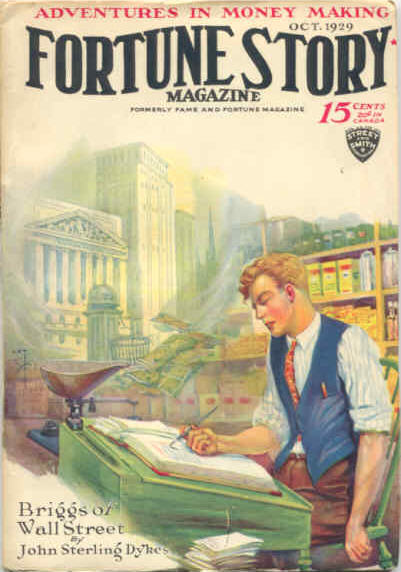This article appeared in the October, 1929 issue of Fortune Story magazine. Fortune Story was a 15¢ pulp magazine filled with these kinds of up-lifting, moralistic tales aimed at impressionable younger readers. The only new information it garnered was G&B’s first office being “in an attic room over an art store”, but the writing is so colorful I couldn’t resist sharing it.
A GREAT ARCHITECT
Fortune Story Magazine, October, 1929 Vol. 27, No. 3
From a two-dollar-a-week office boy to the position of America’s foremost designer of schools is the record of James O. Betelle. The secret of his success can be found in the old formula of hard work plus perseverance which all must follow who seek fame and fortune.
The son of parents of humble circumstances, Betelle had to leave school at the age of sixteen. But the youth early decided to become an architect, and made up his mind that he would provide himself with the best possible education for his chosen work.
He experienced many hardships in his pursuit of knowledge, due to lack of funds. But he capitalized his time, made his spare hours colossal ones through intensified concentration, devoured the technicalities of his architectural studies, enlarged his scope of interests, because he realized that an architect must be a man of broad training with a strong cultural background. And he–sketched, sketched, sketched.
Finally he and another man formed a partnership–Guilbert & Betelle, Architects. Their first office was in an attic room over an art store in Newark, New Jersey. At first there was no salary paid the partners. All money available went to pay for needed draftsmen and other expenses.
Soon they were able to get schools to design. By hard work, by writing articles for magazines of the profession, and by availing themselves of every opportunity to gain publicity, they got their name before the public.
Guilbert died in 1916 and Betelle became the sole guiding force of the organization. Business improved steadily until the World War. Then–bang! Everything was wiped out.
Betelle joined the army and obtained a commission as captain in the sanitary corps. After the war he started business again, and the seeds already sown began to bear fruit. There was a great interest in education–and a shortage of school houses.
In 1919 Pierre du Pont retired from active business to devote himself to improving the educational opportunities of the youth in Delaware, his native State. Du Pont created a fund of several million dollars to carry out this work. Betelle was selected as architect, and designed more than a hundred and twenty-five schools throughout Delaware!
And now cities throughout the country have examples of his art and handicraft. In all he has designed two hundred and fifty schools, besides numerous banks, office buildings, hospitals, clubs, and residences. The cost of the school buildings alone amounts to more than fifty million dollars!
Betelle has not confined himself to his architectural pursuits. He has found time to take an active interest in the civic welfare of his home city, Newark, New Jersey. Twice he has been president of its chamber of commerce. Also, over a period of eight years he lectured at Columbia University.
A tremendously active life! At no time in his career did James O. Betelle sit back and watch the other fellow forge ahead of him.
It seems as though this masterly architect built his own career on an architectural plan–with everything in its proper place and dovetailing, with no part out of harmony with the other.
From the little attic office over the art store, Betelle’s business has grown until it occupies an entire floor in the Newark Chamber of Commerce Building–designed by him. But Betelle’s tremendous business is far overshadowed by his work, which is lasting, far-reaching in its influence on America of to-day and to-morrow.

